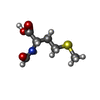+Search query
-Structure paper
| Title | Structural basis of translation inhibition by cadazolid, a novel quinoxolidinone antibiotic. |
|---|---|
| Journal, issue, pages | Sci Rep, Vol. 9, Issue 1, Page 5634, Year 2019 |
| Publish date | Apr 4, 2019 |
 Authors Authors | Alain Scaiola / Marc Leibundgut / Daniel Boehringer / Patrick Caspers / Daniel Bur / Hans H Locher / Georg Rueedi / Daniel Ritz /  |
| PubMed Abstract | Oxazolidinones are synthetic antibiotics used for treatment of infections caused by Gram-positive bacteria. They target the bacterial protein synthesis machinery by binding to the peptidyl ...Oxazolidinones are synthetic antibiotics used for treatment of infections caused by Gram-positive bacteria. They target the bacterial protein synthesis machinery by binding to the peptidyl transferase centre (PTC) of the ribosome and interfering with the peptidyl transferase reaction. Cadazolid is the first member of quinoxolidinone antibiotics, which are characterized by combining the pharmacophores of oxazolidinones and fluoroquinolones, and it is evaluated for treatment of Clostridium difficile gastrointestinal infections that frequently occur in hospitalized patients. In vitro protein synthesis inhibition by cadazolid was shown in Escherichia coli and Staphylococcus aureus, including an isolate resistant against linezolid, the prototypical oxazolidinone antibiotic. To better understand the mechanism of inhibition, we determined a 3.0 Å cryo-electron microscopy structure of cadazolid bound to the E. coli ribosome in complex with mRNA and initiator tRNA. Here we show that cadazolid binds with its oxazolidinone moiety in a binding pocket in close vicinity of the PTC as observed previously for linezolid, and that it extends its unique fluoroquinolone moiety towards the A-site of the PTC. In this position, the drug inhibits protein synthesis by interfering with the binding of tRNA to the A-site, suggesting that its chemical features also can enable the inhibition of linezolid-resistant strains. |
 External links External links |  Sci Rep / Sci Rep /  PubMed:30948752 / PubMed:30948752 /  PubMed Central PubMed Central |
| Methods | EM (single particle) |
| Resolution | 3.0 - 3.2 Å |
| Structure data | EMDB-4638, PDB-6qul:  EMDB-4639:  EMDB-4641: |
| Chemicals |  ChemComp-FME:  ChemComp-MG:  ChemComp-A:  ChemComp-JJH:  ChemComp-ZN: |
| Source |
|
 Keywords Keywords | ANTIBIOTIC / ribosome / cadazolid / quinoxolidinone / 50S |
 Movie
Movie Controller
Controller Structure viewers
Structure viewers About Yorodumi Papers
About Yorodumi Papers






